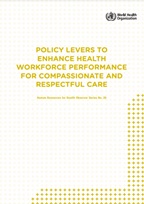About us
Health systems can only function with health workers; improving health service coverage and realizing the right to the enjoyment of the highest attainable standard of health is dependent on their availability, accessibility, acceptability and quality.
WHO estimates a projected shortfall of 11.1 million health workers by 2030 (1), mostly in low- and lower-middle income countries. However, countries at all levels of socioeconomic development face, to varying degrees, difficulties in the education, employment, deployment, retention, and performance of their workforce.
The chronic under-investment in education and training of health workers in some countries and the mismatch between education and employment strategies in relation to health systems and population needs are contributing to continuous shortages. These are compounded by difficulties in deploying health workers to rural, remote and under-served areas. Moreover, the increasing international migration of health workers may exacerbate health workforce shortfalls, particularly in low- and lower-middle income countries.
In some countries, challenges in universal access to health workers may also result from the lack of fiscal space to absorb the supply of health workers. As a result, some countries face the paradox of health worker unemployment co-existing with major unmet health workforce needs.
The High-Level Commission on Health Employment and Economic Growth found that investments in the health and social workforce can spur inclusive economic growth. The health workforce has also a vital role in building the resilience of communities and health systems and in emergency preparedness and response. Approximately 67% of the health workforce are women: investing in the health workforce is an opportunity to create decent employment opportunities, in particular for women and youth.
Our Team
All->Our work
News
Events
Call for consultation
Normative publications

Policy levers to enhance health workforce performance for compassionate and respectful care
The progressive realization of universal health coverage (UHC) requires not only that health services be available and accessible but also that they be...
In 2020, Working for Health expanded its operations in 10 countries (Benin, Chad, Guinea, Mali, Mauritania, Niger, Rwanda, South Africa, occupied Palestinian...
Closing the leadership gap: gender equity and leadership in the global health and care workforce
*UPDATE: 2024 data. According to the National Health Workforce Accounts, women comprise 67.2 per cent of the health workforce globally.Based on data available...
With nearly half of the world’s population living in a rural or remote area, meeting the health needs of rural populations, where over 80% of the...
Additional publications
Mid-level health workers: The state of the evidence on programmes, activities,costs and impact on health outcomes
Ghana: Implementing a national human resources for health plan-country case study
Human resources for health: a gender analysis
Counting Health Workers: Definitions, Data, Methods and Global Results
Health topics
Related teams

